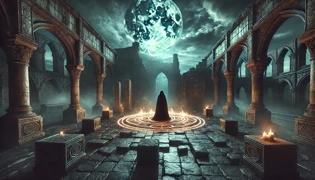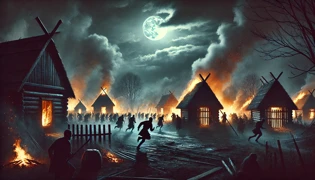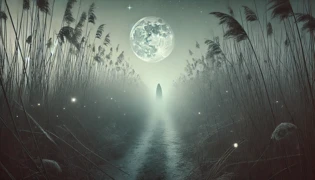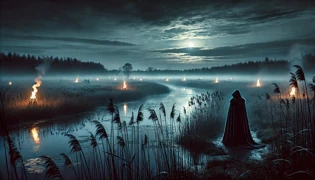Introduction
Stretching beyond the known borders of the realm, the Char-Man Marshlands lie shrouded in swirling mists and flickering embers that dance across treacherous bogs. Under a sky perpetually bruised by twilight, travelers swear the air itself hums with an uneasy energy, as if each breath carries the echo of distant laments. It is here that the name Char-Man Owhay takes hold in hushed tones, a ghost born of flame and sorrow. They say Owhay’s form flickers like dying coals, a silhouette etched by firescars that glow against the creeping darkness. Some recount that he was once a sorcerer, a master of torch and spark betrayed by those closest to him in their greed for power. Others believe he belonged to a humble family of reed-weavers, consumed by a raid that burned home and soul alike. Whether wizard or villager, both tales converge on a man undone by fire’s betrayal, his spirit restless and aching for justice or release. As midnight settles over the reeds, it is his distant moan that pierces the hush, a sound that curdles blood and quickens heartbeat. Campfires flicker out in an instant, lanterns shudder beneath unseen gusts, and footprints vanish into the knee-deep ooze. Guides warn against the cursed trails that wind through twisted trees, insisting that those who stray risk drawing the ghost’s fiery gaze. Few emerge unscarred in body or mind, carrying tales of luminescent orbs and phantom laughter that reverberates long after dawn. Yet curiosity beckons more than caution, and each seeker adds another fragment to Owhay’s living legend. Even the eldest villagers dance around campfires during the Ember Festival, offering flickers of light to placate his spirit, hoping to calm a force they barely comprehend. Tonight, as mist coils like restless serpents and every ember in the torches seems to whisper Owhay’s name, we venture into darkness seeking the truth behind the legend.
Origins Etched in Flame
The first whispers of Char-Man Owhay reach back to candlelit libraries and clandestine gatherings of sorcerers who spoke his name in reverent hush. In one retelling, Owhay was born with a rare affinity for fire, an elemental gift cultivated through sleepless nights of study and sacrifice. He learned to draw flame from the very air, spinning sparks into shapes of beauty or terror by the flick of a wrist. His power was both art and weapon, a brilliant display of raw magic that set him apart from all who walked the realm. Yet such talent carried a price. They say his ambitions grew as his mastery deepened, and he began bending flame to serve personal vendettas rather than the old tenets of his order. Greed and jealousy blossomed in hidden corners, stoked by rival mages who coveted his secrets. In a single catastrophic night, betrayal shattered Owhay’s circle of trust. A trusted ally turned blade and incantation against him, igniting a torrent of flames that consumed the courtyard and all who stood within. Only Owhay remained, claws scorched, flesh seared down to molten bone, a living torch left to wander. His scream echoed through stone halls, a sound more potent than any spell. Though word of this reckoning dimmed among scholars over the years, the embers of that betrayal refused to die. Some claim the sorcerer surrendered his mortal form at death, becoming an undying shade of heat and sorrow. They believe the vengeance he felt in life crystallized into an eternal rage in death, and that he now haunts the marshes in search of the traitor who first betrayed his trust.
A second origin story frames Owhay not as a master of flame, but as an innocent villager named Orwin Hayle, a reed-weaver of simple means and quiet heart. In this version, his home lay nestled deep within the marsh, a cluster of huts raised on stilts above knee-deep waters. By day he wove baskets and bedding from the marsh reeds, his work prized by traders from far-flung towns. But peace was not his destiny. A band of marauders—soldiers displaced by war or bandits hungry for plunder—descended upon the village one moonless night. They set fire to the huts without mercy, their torches painting the marsh in hellish orange while villagers flailed in panic, trying to escape the blaze into the mire. Orwin rushed back into a burning hut to rescue a child, only to be engulfed himself. When the flames receded, they found his body, half-burnt and twisted, the child safe in his arms. Driven by compassion in life, he became a beacon of mercy in death, or so the villagers whispered. But the horrors he suffered also kindled a fury that lingered, an ache for justice that no mortal court could satisfy. They say his ghost rose that night, his form flickering like light through the reeds, neither wholly alive nor entirely dead, drawn forever to the echoes of that violent betrayal.

As generations passed, villagers and scholars alike debated which origin held truest. Some insisted the sorcerer’s tale carried the ring of magic and menace; others argued the reed-weaver story resonated in its humanity. No scroll or parchment laid final claim. Instead, the two narratives interwove like reeds in the wind—distinct strands bound by a common wound. Townsfolk began to mark lanterns with both runic symbols of protection and woven patterns of reeds, hoping to address both aspects of Owhay’s identity. Offerings of charred wood and woven baskets appeared at the edge of the marsh. Through these acts, the living attempted to soothe a spirit that had grown too vast to fit within a single story.
Today, travelers bring their own interpretations to the legend. Some speak of a robed figure chanting incantations amid flickering braziers. Others tell of a silent guardian emerging from the reeds to guide lost wanderers away from dangerous bogs. All agree on one point: Char-Man Owhay is neither wholly evil nor purely benign. His fire-scarred visage carries a dual message—of the perils of unchecked power and of compassion in sacrifice. The marsh breathes with this tension, every rustle in the reeds and every crackle of distant flame reaffirming that Owhay’s true origin may never be known. Instead, his legend endures in the interplay of light and shadow, the embers of myth glowing long after any spark of certainty has faded.
The Night of the Burning
Long before moonrise stained the horizon purple, the village of Wyrdfoot slumbered in deceptive peace. Thatch-roofed huts lay clustered like sleeping beasts, and the faint sound of reeds swaying in the marsh lulled inhabitants into oblivion. It was a night that began like any other, until the crackle of flame erupted from the eastern edge where the reed fields met the treeline. Villagers ran from their beds, faces illuminated by tongues of fire licking the sky. Panic spread faster than the blaze; livestock screamed, children cried, and every heart pounded to the same frantic rhythm. In that chaos, one man—Orwin Hayle—rushed toward the inferno rather than away. His name was destined to be written in ash.
He darted into the burning huts again and again, each time emerging worse for wear but still clutching the precious burdens of others. A mother, blinded by smoke, could only listen to his reassuring voice as he lifted her son from a cradle, placing the child on firmer ground beyond the conflagration. A widow, too old to flee swiftly, felt his arm around her waist as he guided her from the heat. With every act of mercy, the flames licked closer to Orwin himself—singeing his cloak, curling his hair, branding his flesh. Witnesses spoke of his final emergence: a figure half-enshrouded in fire, bearing a frightened child whose eyes reflected both fear and awe. Then the firestorm receded, leaving smoldering timbers and a man who refused to kneel to death.

In one breath, life and legend converged. Some claim Orwin whispered curses upon those who started the fire, his voice echoing down empty lanes as villagers watched in stunned reverence. Others say he fell to his knees and prayed for the souls lost in the flames, tears mingling with sparks that spiraled around him like tiny stars being reborn. When the smoke cleared, there was no body to be found, only a scorched cloak drifting on the breeze and footprints that vanished at the water’s edge. Those who dared follow the prints swore they heard a soft hum of power, neither wholly musical nor wholly mournful.
After that night, the marsh took on an eerie glow. Torches held aloft near Wyrdfoot sputtered out without warning. Lanterns swung along silent docks, casting shadows that moved independently of their source. And every so often, at the darkest hour before dawn, a phantom light would flicker among the reeds. Some travelers pressed on toward safe ground; others turned back, convinced they walked foolishly toward a spirit too powerful to confront. Accounts vary—some describe a hollow-eyed figure beckoning for aid, others recall a fiery visage roaring in fury when approached. Yet all agree that it was the same presence born from that night of burning.
Over time, merchants and pilgrims arriving at Wyrdfoot instilled cautionary rituals into their trade. They tied lanterns to the heads of horses, danced around campfires with salt and protective runes, and left offerings of water and smoke to appease the ghost. These measures did not halt the sightings but shifted the narrative: Owhay could be placated, or perhaps engaged, rather than simply feared. On rare occasions, those who left marsh tokens at the water’s edge found them returned at dawn, their bindings untied, reeds neatly woven. Was this an act of mercy or mockery? Villagers still debate. But the night of the burning remains the cornerstone of every telling, stamped into memory by the scent of charcoal and the echo of a man who refused to die normally.
Haunted Trails and Spectral Pursuit
The marsh holds a thousand paths, each a winding maze of reeds, hidden pools, and sunken logs. For the unwary traveler, one misstep can mean boots lost in the mire or a twisted ankle that spells doom under the moonless sky. Guides who know these lands by memory warn of the spectral chase—the moment when terror flares and the light of every lantern dims.
It begins with a whisper on the wind, a voice too soft to comprehend but too urgent to ignore. Some hear it in their sleep, others in tense silence broken by distant hoots. Then come the embers: small, glowing motes that drift through the reeds like restless fireflies. Approach them, and they retreat; follow deeper, and they twist out of sight, drawing you down narrow channels where roots snag cloaks and branches whip faces.

Those who have fled describe a form materializing from the mist: a tall figure wreathed in ember-light, flames pulsating beneath charred flesh like a heartbeat. His eyes burn with an inner fire that pierces night and soul alike. He does not speak, or if he does, his words are indistinct as crackling logs. Still, his intent is clear—he pursues with single-minded purpose, his stride unerring across bog and boardwalk alike.
Panic sets in when you hear your own footsteps fall silent behind him. Lanterns gutter to nothing, leaving only the dull glow of his scars to guide the way. Travelers sprint blindly through reed tunnels, arms outstretched, presuming safety is within reach. Yet every exit seems to loop back, every landmark repeats. Breath grows ragged, lungs burn, and fear becomes a tangible force driving you onward—or holding you in place.
“They never catch me,” one merchant boasted after returning empty-handed from a nighttime crossing. “I felt him on my heels, heard his rasp, but dawn’s red light spilled through the haze and I was free.” Conversely, a young hunter told a darker tale: “I stumbled. My lantern died. Then I was at his mercy. I felt his cold hand on my shoulder, heard the sizzle of flame in my ear. I promised all I had if he’d let me live.” The next dawn revealed his footprints trailing off into the marsh, unaccompanied.
Over centuries, legends grew more elaborate. Some say Owhay’s chase is a test of courage, designed to teach humility and respect for the marsh’s power. Others insist it is pure vengeance, a torment for those who trespass or mock his myth. Local lorekeepers debate whether offerings of reed talismans can turn the hunt into a partnership—one that guides rather than hunts.
Today, modern travelers rely on lantern charms and GPS wards scrawled in runic ink. Yet even the most advanced protections falter beneath Owhay’s brimstone gaze. He moves through myth and reality alike, reminding all who wander that some legends cannot be outrun. And though many flee his presence, an even braver few seek him out—drawn by the hope that in aiding this restless spirit, they might unearth the final piece of his fractured tale.
Conclusion
As dawn’s first light bleeds across the marsh, the embers of Char-Man Owhay’s legend smolder quietly under drifting dew. Whether born of arcane betrayal or humble sacrifice, his story has entwined itself with every reed and every flicker of midnight flame. Guides still caution travelers against straying too close to the bogs, urging lanterns, wards, and heartfelt offerings to temper the ghost’s restless chase. Yet others argue that only through understanding—through piecing together both tales and honoring both sorcerer and villager—can the fire-scarred spirit find rest. Across centuries, the marsh has borne witness to whispers around flickering campfires, to footprints that vanish at water’s edge, and to lanterns inexplicably doused by unseen breath. In every telling, Owhay endures: neither wholly vengeful nor entirely merciful, but a living testament to the paradox of flame and the human heart. The Char-Man Marshlands will continue to call to those brave enough to wander its misty paths, offering both peril and possibility. For in the heart of every legend lies a seed of truth—and perhaps, if one listens closely, the final ember of redemption glowing amid the reeds would reveal the true nature of Char-Man Owhay’s fate. Only then might his spirit finally rest beneath the morning sun, freed from the endless dance of vengeance and hope that has defined him for generations.


















